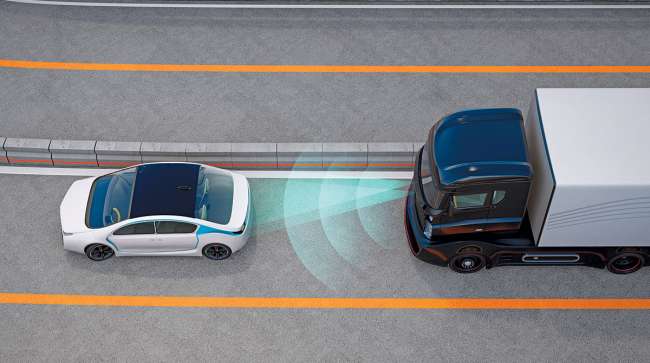Senior Reporter
Trucking Trade Groups Generally Support AEB Proposal

[Stay on top of transportation news: Get TTNews in your inbox.]
Organizations representing heavy trucks were generally supportive of a joint proposed rule to require automatic emergency braking technologies on heavy trucks — with caveats.
But comments from some, including dozens of individual truck drivers and a few of their organizations, dubbed the idea of a sudden AEB stop going 50 or 60 mph as potentially dangerous.
With in-depth responses by many of the commenters, it was obvious they were taking seriously the complex, detailed 288-page proposed rule, a mandate in the Infrastructure Investment and Jobs Act.
The proposal’s comment period closed on Sept. 5.
The joint AEB rule of the Federal Motor Carrier Safety Administration and National Highway Traffic Safety Administration gives Class 7 and Class 8 fleets and owners three years after the final rule to meet the requirements, and four years for vocational and certain other categories of trucks over 10,000 pounds. But the idea of including AEB technologies for Classes 3-6 trucks is not ready for prime time, many commenters said.
Still, written comments by American Trucking Associations expressed mostly support for the AEB rule, but emphasized that the technology needs to be driver-friendly and well tested, cautioning NHTSA and FMCSA to not discount driver concerns over false activations, adverse weather performance or unintended consequences.
“ATA recognizes that AEB is a lifesaving technology and many of ATA’s members have already adopted AEB into their fleets with positive results,” ATA wrote. “However, ATA also recognizes that the design of AEB is to mitigate crashes, not prevent them, and that driver trust remains a major barrier to maximizing the potential of not only AEB but Advanced Driver Assistance Systems more broadly.
“A well-trained and attentive driver is the safest thing you can have on a truck, and technology that supports drivers rather than hinder them or erode their trust will achieve the best safety outcomes.”
ATA said it also believes that NHTSA and FMCSA have underestimated the complexity of implementing an AEB requirement across the many different vehicle configurations and the many different secondary manufacturers. There are many vehicle configurations that would “explicitly interfere” with the sensors necessary for AEB, ATA added.
“While this rulemaking would require AEBs to be placed on our equipment, we would be remiss if we did not insist that the trucking industry allow for a natural attrition of this technology to improve rather than a time-based deadline that could be difficult to achieve,” the Truckload Carriers Association wrote. “We applaud NHTSA and FMCSA for continuing to investigate the cause of these failures as we continue to find ways to a zero-accident nation.”
The Truck and Engine Manufacturers Association had the following to say about the proposal:

Transport Topics' Seth Clevenger, Michael Freeze and Mike Senatore dissect the new Top 100 list of the largest private carriers, including how fleets are adapting to this softened market. Tune in above or by going to RoadSigns.ttnews.com.
“The NPRM presents numerous complex issues and technical challenges. Electronic Stability Control and AEB are proven safety technologies for truck tractors, and yet they can present unintended negative safety consequences if they react too aggressively or activate when not needed.
“Careful balancing of the proposed standards is critical to ensuring the intended benefits of the technologies are achieved in use.”
The American Truck Dealers division of the National Automobile Dealers Association wrote that it believes an AEB mandate can help to reduce collisions with commercial motor vehicles and improve safety on U.S. roadways, and that it generally supports the agencies’ proposal.
“However, ATD is concerned about certain technical issues, lead time and costs presented by the NPRM that could directly impact its members and their customers,” the dealers’ group said.
Daimler Truck North America said it too supports the rule in general, but said the background research for truck tractors may provide a framework or starting place for the future development and expansions for vocational vehicles, “but it should not be assumed, as the proposed rule does, that a one-size-fits-all approach is sufficient for all heavy-duty vehicles without the necessary predicate research.”
But not everyone said they supported the rule.
Want more news? Listen to today's daily briefing above or go here for more info
“We know from member companies’ driver experience with AEBs that these features put the lives and safety of truck drivers and the people in vehicles near them in jeopardy every day,” wrote the National Association of Small Trucking Companies. “AEBs sometimes suddenly slam on a truck’s brakes. This catches the truck driver by surprise.”
That notion was supported by dozens of comments from individual truck drivers. Here’s one of them:
“I lost a load of milk when a shadow had the truck slamming on its brakes and I came to a complete stop on I-70 outside of Denver,” wrote Laura Lindsay of Goodson, Mo. “With the truck doing what it did, it caused the cars behind me to swerve to the shoulder to not slam into the back of the trailer, causing a massive pileup.”




